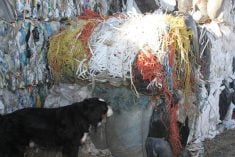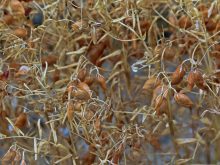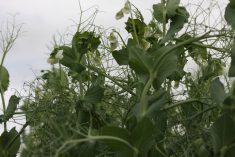SASKATOON – The prairie patchwork of fields may have less yellow in it if researchers are successful in developing a petal-less canola.
Researchers at Zeneca Seeds in Winnipeg have been looking into producing a petal-less canola resistant to sclerotinia, a disease that can cut yield by as much as 20 percent.
“The crop is really only susceptible when it’s flowering because the petals are essential in order for infection to occur,” said Robin Morrall, a biology professor at the University of Saskatchewan.
Sclerotinia, or stem rot, is a disease that causes premature ripening of canola.
Read Also

Alberta looks for agricultural plastic management input
Alberta provincial government giving agriculture industry a say through survey in shaping future plastics management
Stem rot starts as a fungus on the ground. It produces mushroom-shaped bodies that release spores. The spores fly up and land on the petals.
When the petals fall off, some land between the leaves and stem of the plant.
“The spores germinate, use food from the dead petals, and go into the plant,” said Morrall.
The stem weakens, the plant ripens early and dies. If there are no petals, the disease has a harder time getting into the plant.
Lacking familiar flower
“It would be interesting to see how growers accept a canola that doesn’t have that familiar bright yellow flower,” said Dale Burns, a plant breeder with Zeneca.
The petal-less trait occurs naturally, but very rarely, in Argentine canola.
Zeneca researchers are attempting to purify the trait and combine it with other genes to produce a high-yield, quality canola plant resistant to stem rot.
“When you combine that (petal-less trait) with the need for yield, oil, protein, blackleg resistance and so on, it’s quite a few traits to fit into one (genetic) line,” said Burns.
He was reluctant to give a date when a new canola might be ready to hit the market, saying the research is a drawn-out procedure.
As well, researchers have hit a snag.
Without petals to settle on, honey bees don’t seem as effective in pollinating the plants. Instead of settling on the flowers and being dusted with pollen while collecting nectar, the bees are taking nectar from the side of the plants and not spreading the pollen.
“The result is you don’t get good pollination,” said Burns.
Sclerotinia is common in many canola fields. It can remain dormant in the soil for years and spring up when conditions are right. It favors warm, damp conditions.
In addition to helping with sclerotinia, some European researchers say petal-less canola might produce higher yields.
“The thinking is that the petals actually reflect the sunlight,” Burns said. “They claim that because you don’t have petals reflecting the sunlight, you actually get more photosynthesis occurring because the sunlight is better trapped by the leaves as opposed to being reflected.”
But the Zeneca breeder is skeptical on this point.
“We’re more or less interested in getting out the product and making sure it has the performance.”
Zeneca’s goal is to make the new canola a hybrid strain, which means cross-breeding two different types of canola to get the petal-less plant.














